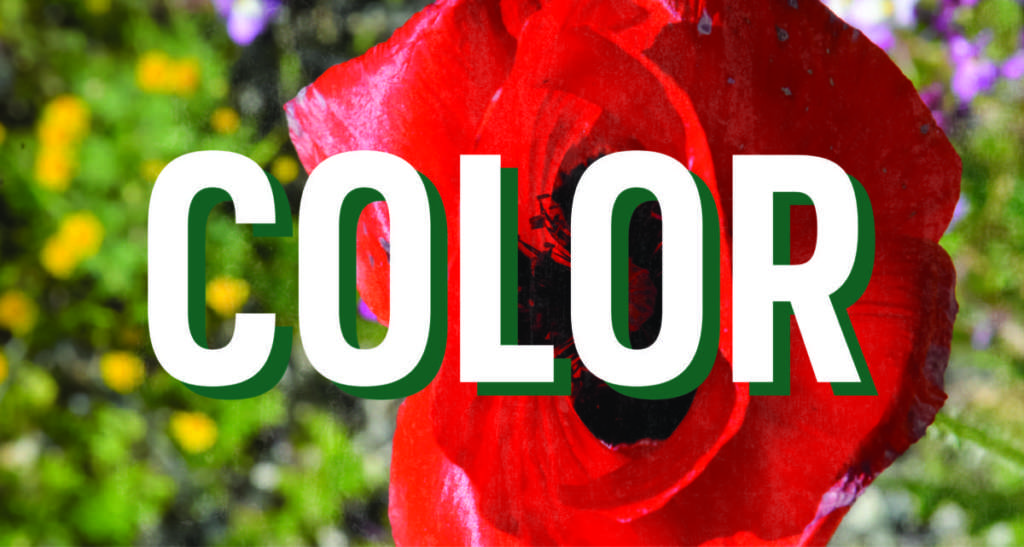Your Pollination Station
Bats, birds, butterflies, and bees all contribute to the survival of our terrestrial ecosystems. It is estimated that 90% of all flowering plants depend on animal pollinators to help them reproduce and that includes about 35% of the world’s food crops – consider that one bite in three at the dinner table depends on animal pollinators. Fruits and vegetables come immediately to mind, but foodstuffs from your cup of coffee in the morning to that glass of wine with an artisanal chocolate bar at the end of the day are also the direct result of animal pollination. In fact, in the United States, the pollination services provided by honey bees and other insects directly impact 150 different food crops and result in $20 billion worth of agricultural products each year.

Bees
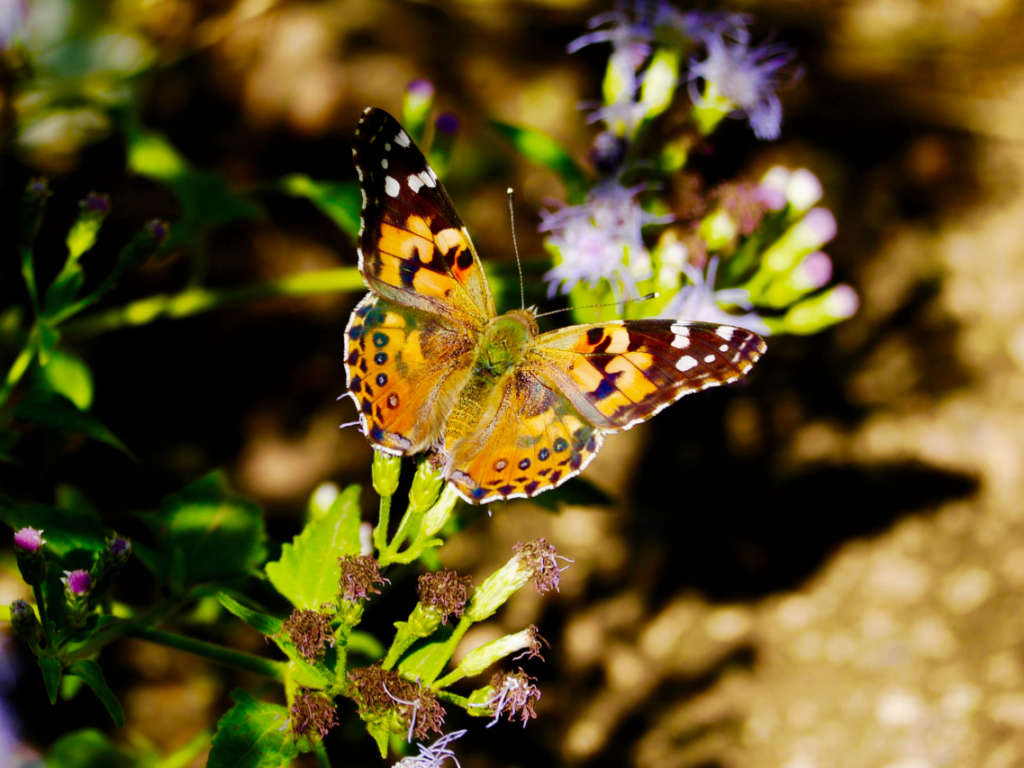
Butterflies
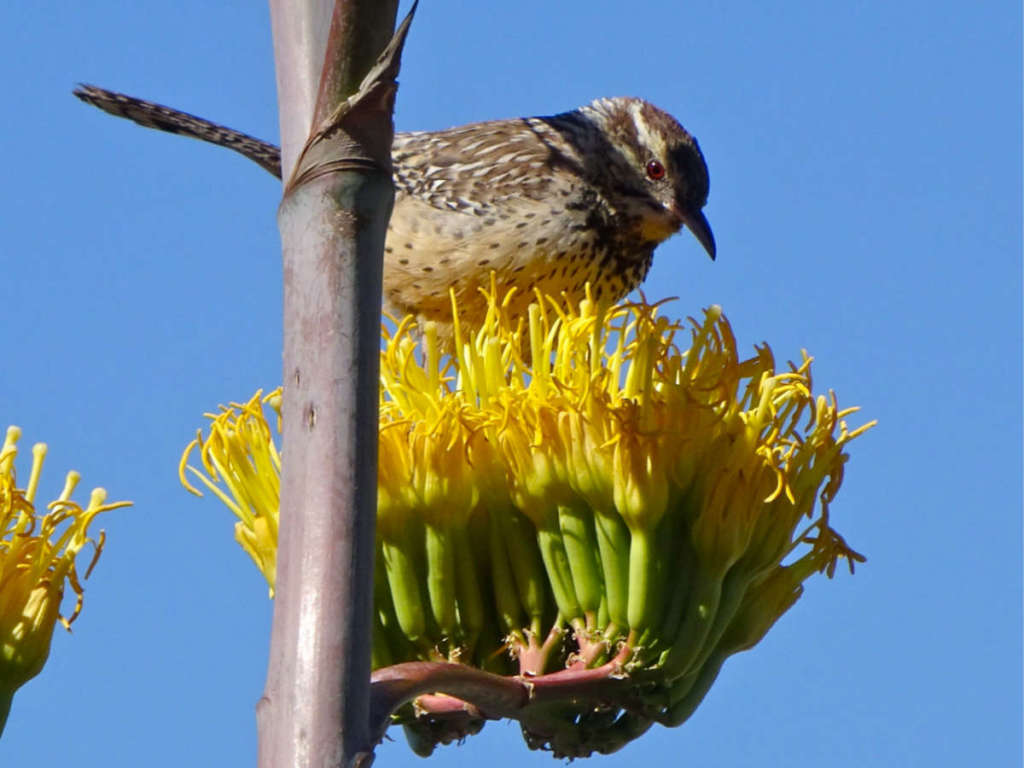
Birds

Bats*
More Info
DAY 1 – Get to know your pollinators
Keep the Hives Alive – Documentary
In June 2016 a group of beekeepers, farmers, community organizers, environmental groups, and concerned citizens banded together to host the “Keep the Hives Alive Tour” to raise awareness about the plight of pollinators and how toxic pesticides contribute to their decline.
Bats And Tequila: A Once Boo-tiful Relationship Cursed By Growing Demands – Podcast
Listen to this insightful two-minute podcast from NPR discussing the importance of bats and their direct relationship to alcohol spirits.

Home Sweet Home Activity
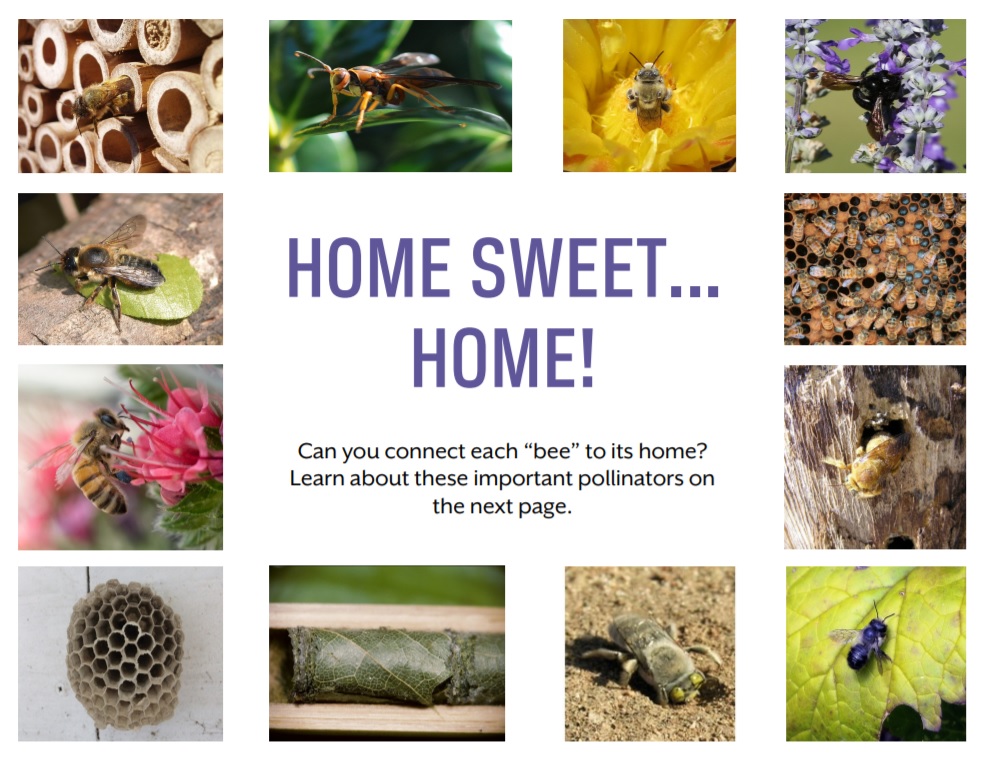
Can you connect each “bee” with its home? Learn more about these important pollinators on the next page.
Bat Myths & Facts Fun Book
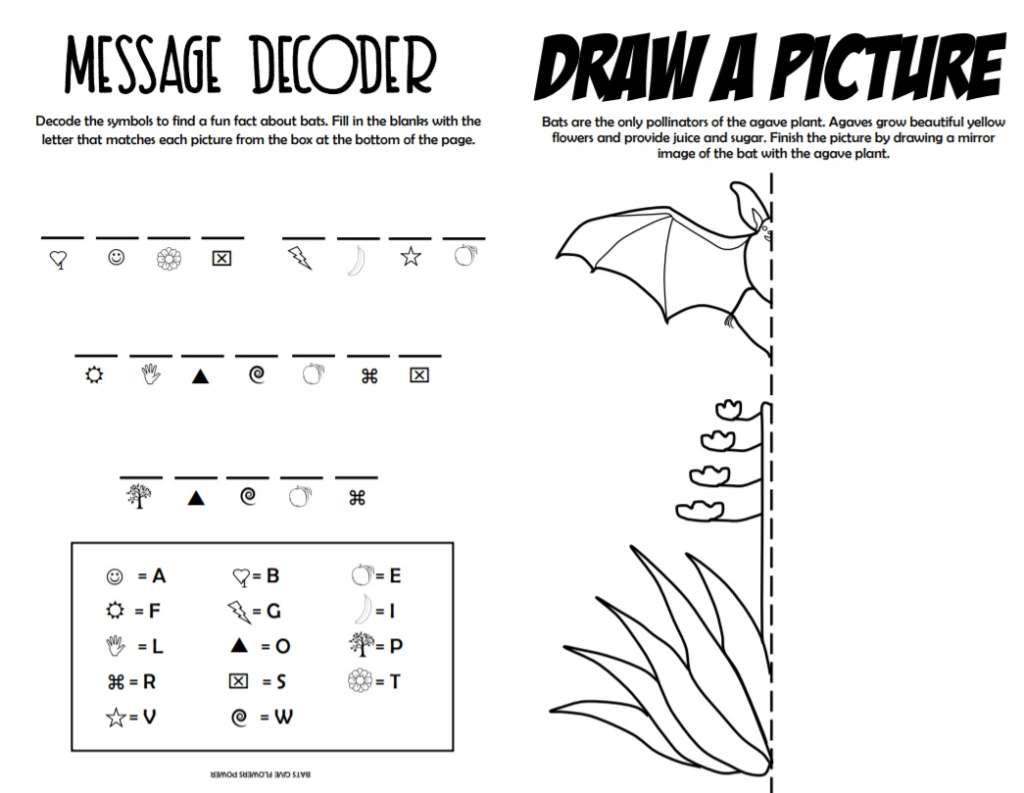
Pollinator Hotspots Citizen Science Program

Sign up for Arizona-Sonora Desert Museum’s program!
Through the Pollinator Hotspots citizen science program, we are inviting all interested Sonoran Desert residents to help us collect data that we can use to identify these hotspots. Participants will collect fruit of barrel cactus, count the seeds, and report the number of seeds found and the size and location of the source plant. With enough data, we will be able to identify areas with consistently high seed production, which we can then further explore to determine if high seed production is linked to high pollinator densities.
Bee’s Eye View
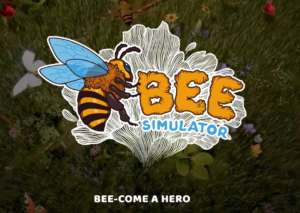
Did you know you can purchase an online bee simulator game?
BEE A GUEST IN THEIR HONEYPARK – Change your perspective and explore a vast semi-open world inspired by Central Park through the eyes of a bee.
EMBARK ON BIG ADVENTURES AS A LITTLE BEE – Save your hive from destruction. Your fate – and that of the whole swarm – is in your tiny hands!
FIND STRENGTH IN NUMBERS – Play with friends or family in split screen with up to 4 players on dedicated maps.
DAY 2 – Build Your Own Pollinator-Friendly Garden
Planting Guides –
Regional Plant Guide by the Pollinator Partnership

Abundant and healthy populations of pollinators can improve fruit set and quality, and increase fruit size. In farming situations, this increases production per acre. In the wild, biodiversity increases and wildlife food sources increase. The beauty of the situation is that by supporting pollinators’ need for habitat, we support our own needs for food and support diversity in the natural world.
Integrate Water-Wisely Gardening

Desert plants are challenged by hot and arid growing conditions. Water-wise gardening addresses their water needs and defines the best growing locations. But how can we be more confident that the timely pollination needed to set seeds, fruits, or nuts is accomplished? The answer is desert native bees, master pollinators of desert plants. This is best done by increasing the availability of flowering plants preferred by desert native bees and expanding their habitat.
Already have a garden? Learn how to enhance it!

The list is organized by native forbs, tree and shrub species, riparian plants and non-native plants that can provide beneficial pollinator habitat. Within each growth type, the list is further organized by approximate bloom times (early, mid, late season). This list should be used as a reference tool for developing conservation alternatives.
Videos –
Habitat Restoration and Management

This series highlights presentations given by professional land managers and conservation scientists who are recognized for their expertise in monarch conservation, implementing monarch habitat projects in targeted land-use scenarios, and long-term habitat management.
The hidden beauty of pollination
Pollination: it’s vital to life on Earth, but largely unseen by the human eye. Filmmaker Louie Schwartzberg shows us the intricate world of pollen and pollinators with gorgeous high-speed images from his film “Wings of Life,” inspired by the vanishing of one of nature’s primary pollinators, the honeybee.
Like Fruit? Thank a Bee!
You might enjoy a delicious peach or slice of watermelon this summer, and it’s largely in thanks to our pollinating friends: the BEES!
DAY 3 – Artistic Expression
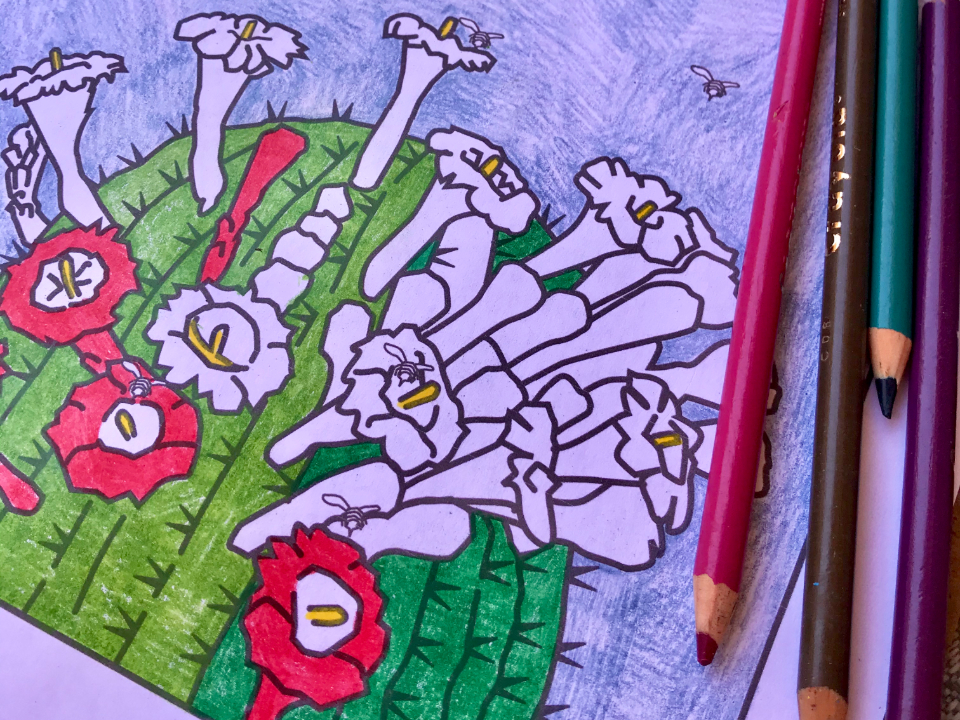
Color these Sonoran Desert pollinators thanks to local artist Tom Baumgartner!
Get more coloring sheets from the
Desert Botanical Garden!

Some of Tom Baumgartner’s Work
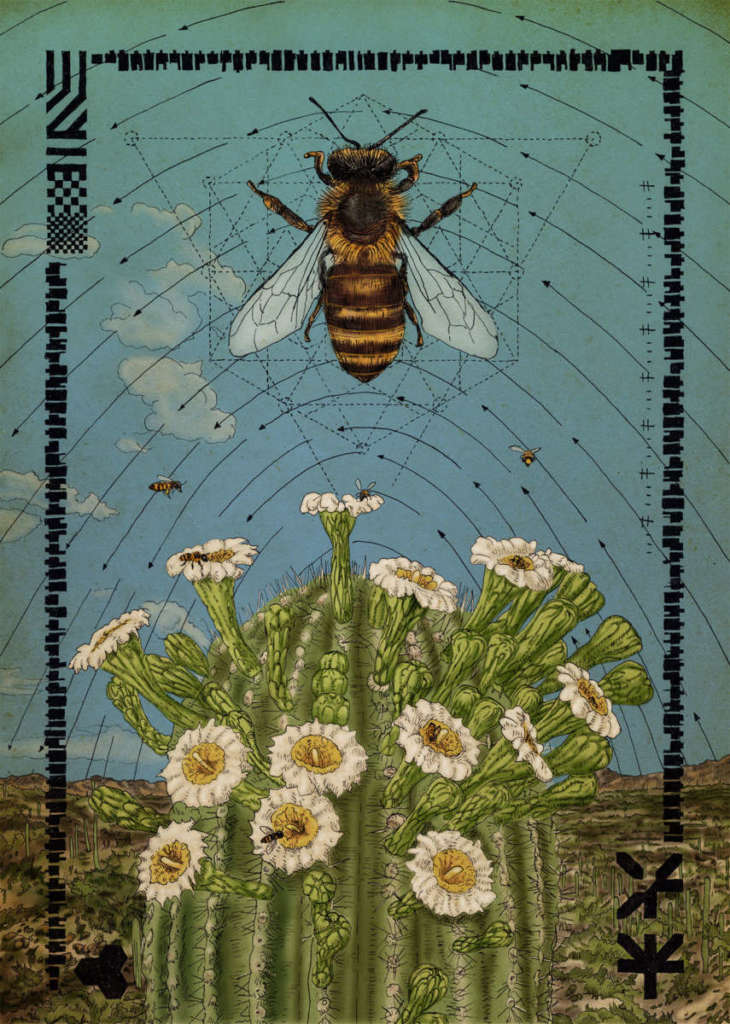
Apidaex – offset lithograph
The last ice age pushed into the Sonoran Desert and pushed out the saguaro cactus and the ironwood trees down to the middle of Mexico and replaced them with juniper forests and giant sloths.
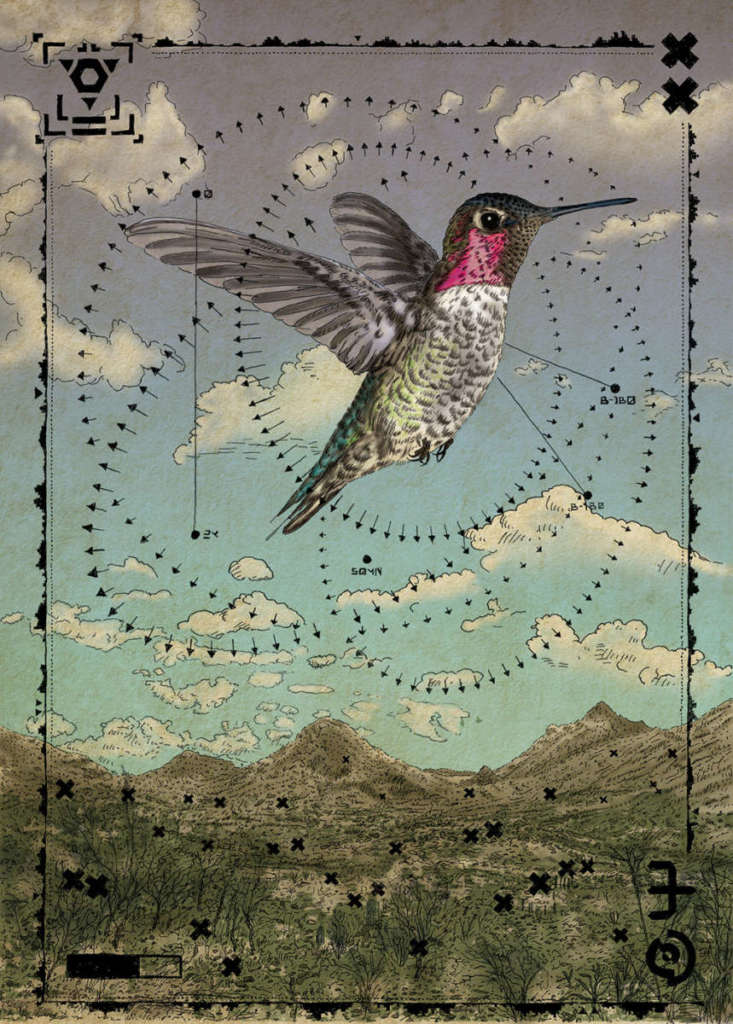
Calyptix – offset lithograph
In this piece, I was thinking of a couple things. One, the bird’s constant role as pollinator. Two, the maneuverability and miracle of its hovering flight, not to mention the iridescent ruby pink throat of an Anna’s Hummingbird.
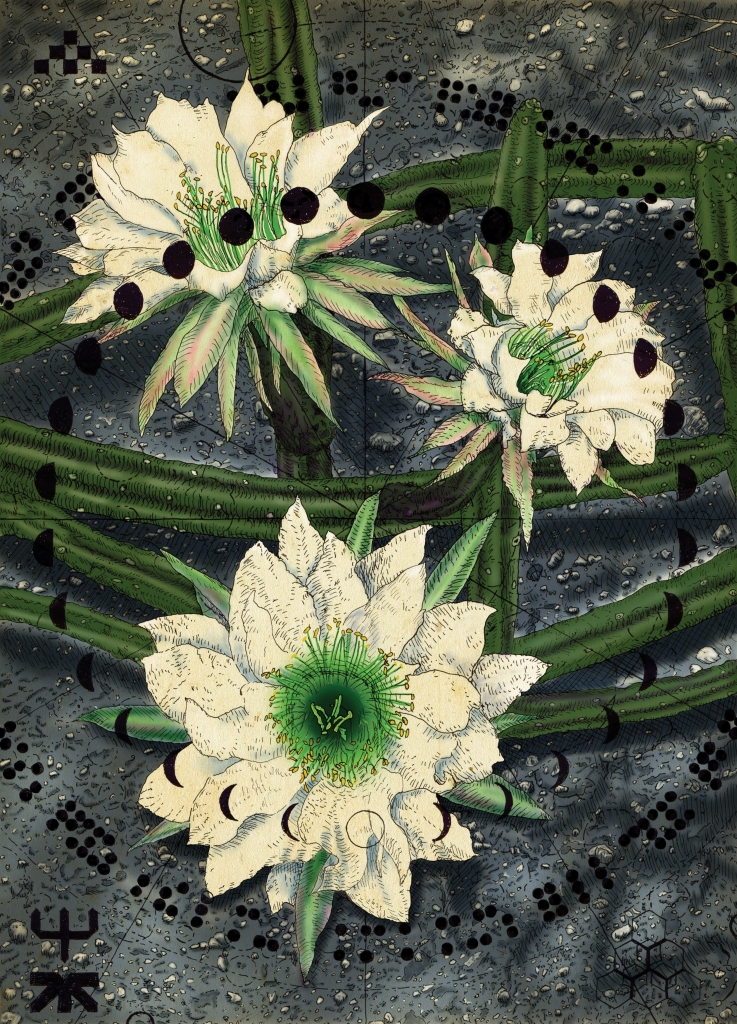
Cereus Lunix – offset lithograph
Flowering plants have symbiotic relationships with pollinators, but I was thinking about the cereus and its relationship with night. The timing of the moon cycles, quietly glowing shadows and moon light being the first light to illuminate the tissue paper thin petals.
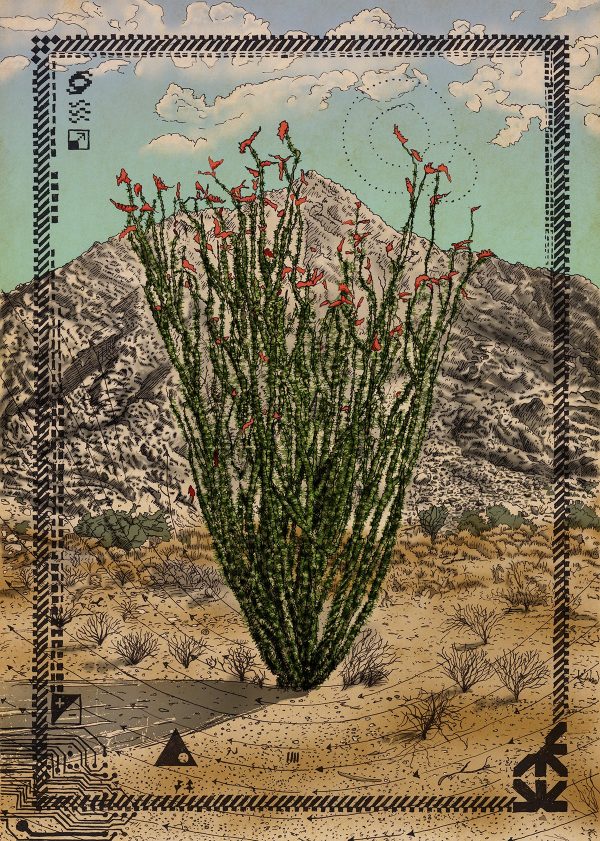
Ocotillix Rosario – offset lithograph
In the Sonoran Desert, some areas get more rain than others. Around Tucson, the yearly rainfall is 12 inches, but in the El Pinacate y Gran Desierto de Altar it’s closer to 3 inches, if any at all.
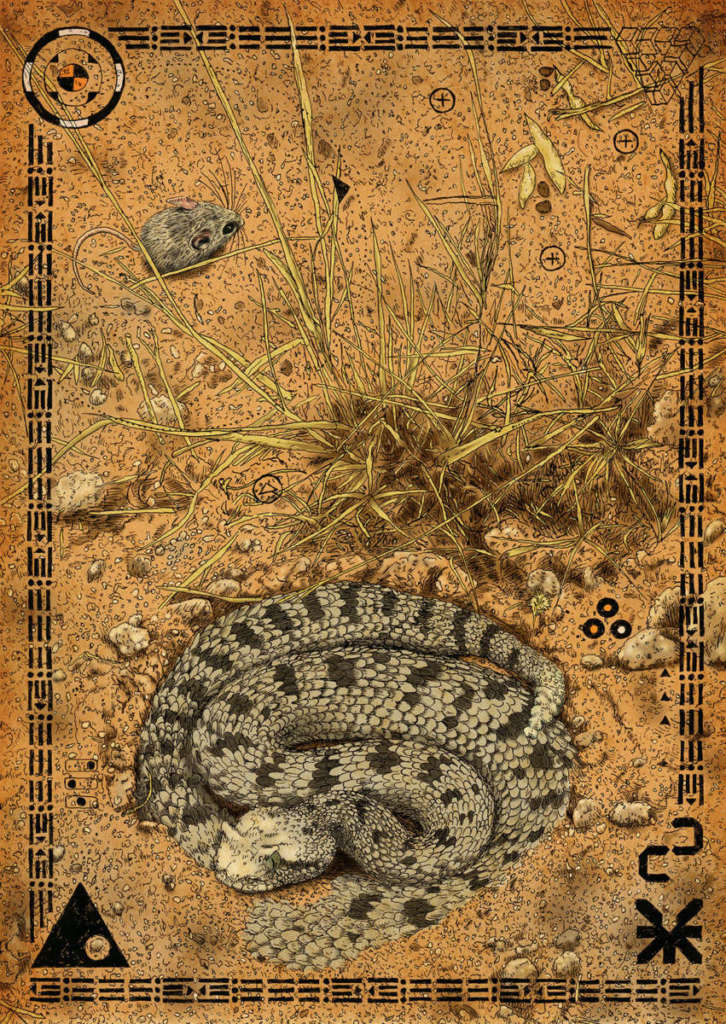
Mohavix – offset lithograph
Beyond symbiosis is the interconnections of an entire ecosystem. With this piece, I was thinking about margins and targets. Margins of the senses, margins of territory, margins of safety. Margins are breached by predator and prey.
More
When the cold receded, the Saguaro came back to Arizona thousands of years faster than the ironwood. Why? Birds. Birds can migrate hundreds or thousands of miles dropping seeds from the saguaro fruit along the way. Ironwood seeds are also eaten and pooped out by pack rats which have small domains of a mile or more.
But first, plants need pollinators. In the desert, these are bats, insects, and bees. They are genetic networkers for the plants they forage. They will forage up to 4 miles and periodically, the whole hive will strike out and find a new place to resettle. Which makes me think of computer networks and networking software, site visits like to a blog and social media. Insects with a queen are really one organism. Grouped together, I image a hive to be the size of a small dog. A small dog with 10,000 stingers. I have encountered a hive on the move while hiking. I heard them before I saw them. I always give them space and respect because they can be aggressive. Our bees down here are Africanized, Africanized hybrids, aggressive, but are immune to the fungus that is killing bees elsewhere.
More
Wings flapping at twice the speed of any other bird with 360 degrees of vision and energy, enough to stay in flight for 50 minutes at a time. Imagine the invisible swirls of air currents churned up around it. The tiny, squeaky chirp is the actual frame of the piece represented by graphic sound waves that you might find in an audio program. The X’s in the piece are a comment on the path a bird may take throughout the day. Hiking through the desert, the dull ring of silence may only be broken by the gravel crunching under your boots. Even if nothing seems to move, you will undoubtedly encounter a hummingbird. You will undoubtedly hear their high-pitched tweets.
More
Flowering plants have symbiotic relationships with pollinators, but I was thinking about the cereus and its relationship with night. The timing of the moon cycles, quietly glowing shadows and moon light being the first light to illuminate the tissue paper thin petals. I was thinking about those tissue paper thin petals unfolding in the moon light, the first light to reflect back their pure whiteness. Overlaid in the background is a target, personal space symbols and a dotted diagram of moon craters. During the summer in the Southwest, there is great celebration centered on the Night Blooming Cereus. There is a great variety including the Queen of the Night that blooms only once a year; catching these lotus-like blooms on their special night is a real treat.
The specimen depicted in my piece resides in my back yard. Blooming at night makes sense, when your main pollinator is bats. This succulent spreads out low along the ground, usually under shrubs or trees. It is not a Queen of the Night and blooms multiple times a year.
More
Rain is usually sourced by a Pacific hurricane or tropical storm coming inland to die. Hardy, adaptive plants, like the ocotillo, growing in an area with less rain may look young but can actually be very old. How old? Sometimes more than 100. In between rains, an ocotillo dials its metabolism down to a crawl and appears to be a bundle of dead, spiny sticks. When it rains, it springs into action by sprouting leaves and bright red, torch-like blooms. Pollinators, like carpenter bee and hummingbird, are attracted to the blooms. This ocotillo was found in the Gran Desierto de Altar at the foot of the Sierra del Rosario Mountains. I was taken by the height of the ocotillos in this area compared to most of the shorter, ground-hugging plants and the sound of wind through their spiny branches.
More
Territories filled with targets of seed bearing plants and rodent trails. Safety is staying outside the margins and sometimes below the ground’s surface. I imagine these invisible zones growing and shrinking from minute to minute as creatures hunt and hide. Plants set up slower seasonal margins of fruiting and flowering, as well as being a home to birds, lizards, insects and rodents. If you can see these invisible margins, you realize the dynamic interconnections of the desert biome. The overlay frame is made of word processor icons: center, list and margin.
The Mohave Rattlesnake is the most venomous and hottest to strike of snakes in the Sonoran Desert. That being said, her symbiotic relationship with rodents is immeasurably important to the ecosystem. She is just doing her job very well.
DAY 4 – Artistic Interpretation
Turn What You See Into A Nature Journal By Tohono Chul Docents!
A quick overview of nature journaling with Jeanie Honn
A more in-depth guide by Olivia Carey featuring materials
A more in-depth guide by Olivia Carey featuring sketching techniques
Pollinator-Friendly Artwork by Greg Corman!

Bee habitat – at the Phoenix Zoo
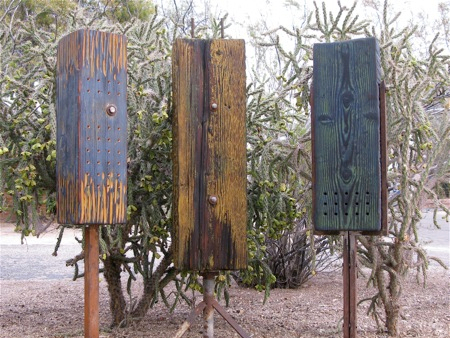
Free standing bee habitats
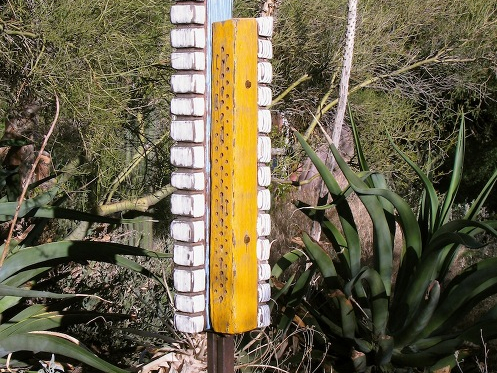
Bee habitat at AZ Sonora Desert Museum
Corman creates sculpture and functional objects primarily from used wood and steel. He aims to highlight the intrinsic beauty and history of the materials, so things like nail holes, gouges, burn marks, and old finishes become features of the pieces. His aesthetic is influenced by mid-century abstract sculpture, African tribal art, Japanese architecture, and the textures and colors of desert landscapes. Some of his work even provides habitat for solitary native bees! These critical desert pollinators are solitary, passive, and safe to have around children and pets. The habitats WILL NOT attract honeybees and killer bees.
Blog by James Schaub – Curator of Exhibitions
I think that the first time you encounter an artist’s work, and are moved by it; that piece, that body of work, that period – becomes the one you hold the highest. Not yet privy to their previous work and unable to anticipate what will come next – the initial impact that grabs you and holds you is what you remember, it resonates endlessly. The discovery of that work is an epiphany.
Read More
I experienced Greg Corman and his work for the first time in Spring of 2011. My son William and I were visiting the Arizona Sonora Desert Museum and encountered several beautiful and minimalist wooden sculptures, distressed in surface and in color, they were literally buzzing with excitement. We spent more time with them than anything that day. Trying to establish a logic to their design, I got lost in the history of the wood and the holes drilled in it, laid out like some lost language – my son got lost in the similarly unpredictable patterns of bees flying all around us, and to his amazement, not one creature was bothered in the least by our presence.
It took a while to even get to the label that read “Bee Condos” – but once there, the information Corman relayed was straightforward and captivating.
“Arizona is home to over 1300 species of native bees, several of which use tunnels in wood as nesting habitats. The tunnels drilled in these sculptures are sized to attract resin, mason, and leafcutter bees, which are solitary, passive pollinators. They will not sting, chase you, or land on your lunch!”
On the way home we stopped at Home Depot bought an eight foot length of Douglas Fir 4” x 6”, went home, cut it in half, and joined it together. The next day William learned how to use a drill.
When we were finished, we nestled it below a tree and waited.
About a year later, bees had found our creation and then this article appeared in the paper:
I had to meet this guy. And, I did.
In 2013 I was curating the exhibition The Exotic Sublime: Explorations of the Desert Southwest at my then gallery ATLAS Fine Art Services. I called Greg, told him how much his work impressed me and invited him to bring a sculpture in. He asked if I wanted to consider several pieces he had available. I visualized how perfect his work would pair with spare elegance the other artists would bring to the space. I told him “he knew his work better than I did.”
It has been that way ever since.
Imagine my delight, when in 2014 I became the Curator of Exhibitions at Tohono Chul. One of Greg’s Bee Habitats was installed in the Gardens and several others, inspired by him, were
installed in the Ethno-Botany Garden. It didn’t take long before we started working together. Greg has been a fixture in many of the great things Tohono Chul does. Beyond exhibiting his artwork in the Gardens and the Galleries, Greg also works with our Director of Education Jo Falls on educational and travel programs. The results are always excellent.
As our Featured Artist in the Welcome Gallery a few years ago, Greg told me he was working with timbers that he gathered from Fort Naco, AZ, they were over a 100 yrs. old when milled and that was over 100 years ago. He waxed poetic about their density and slow growth patterns, about the stories each piece of wood offered him. He has a reverence and respect for these repurposed materials he finds and revives. I have seen Greg work with every tool and with material imaginable – he expects a lot from himself and the same from his materials. He is always pushing for more: more meaning, more ideas, more beauty, more life.
Greg’s work has also figured prominently in numerous Main Gallery exhibitions over the years, Pollen Path in 2019 the most recent. So, with that exhibition title in mind – How could I, as Curator of Exhibitions, put together an exhibition that focused on pollinators and not have Greg Corman in it? I called him, asked him that very question, waited for his response, and told him “he knew his work better than I did.”
Sound familiar?
Greg Corman, simply put, see things most people don’t. He sees possibilities everywhere and in everything.
Learn How To Build Your Own Native Bee Habitat!
How to Make and Manage a Bee Hotel: Instructions That Work
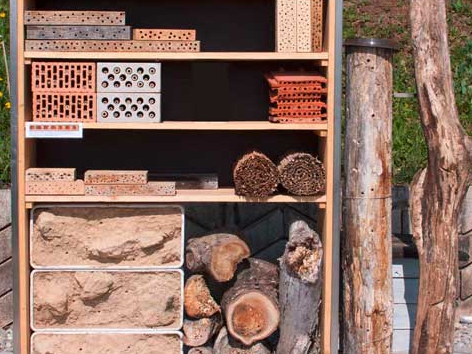
Building insect hotels, with 21 examples
DAY 5 – Weekend Inspiration
Get Into The Spirit Of Spring With These Themed Boxes!
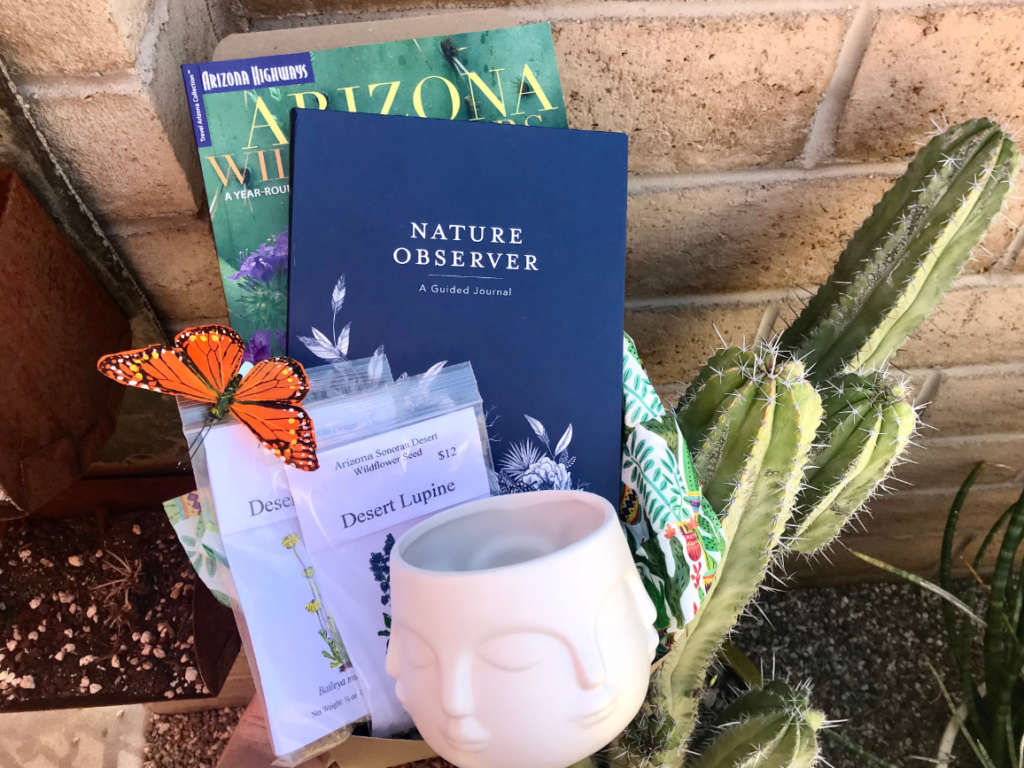
Nature Box – $81
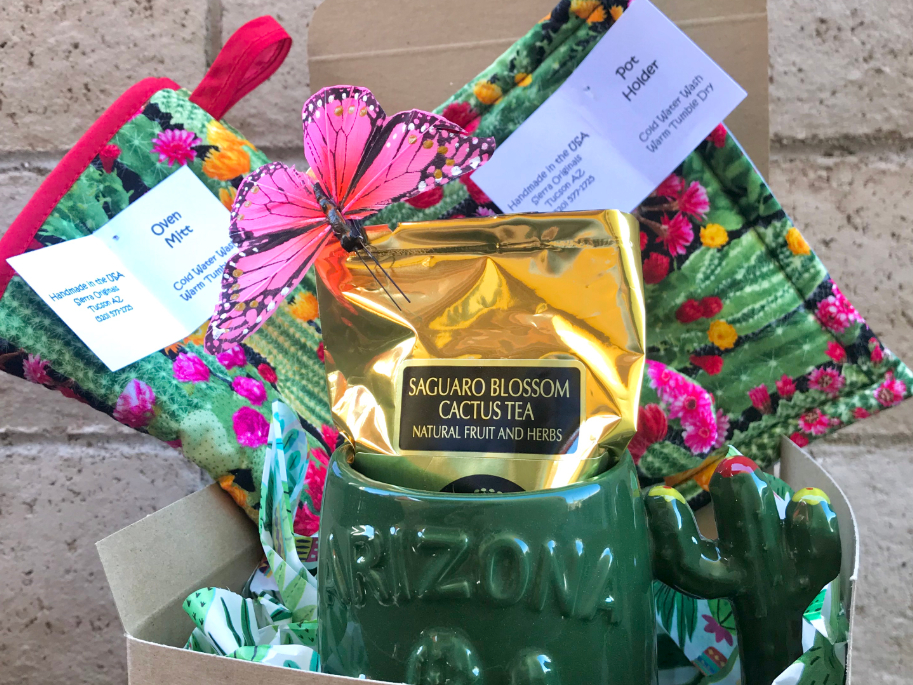
Cactus Kitchen Box – $55
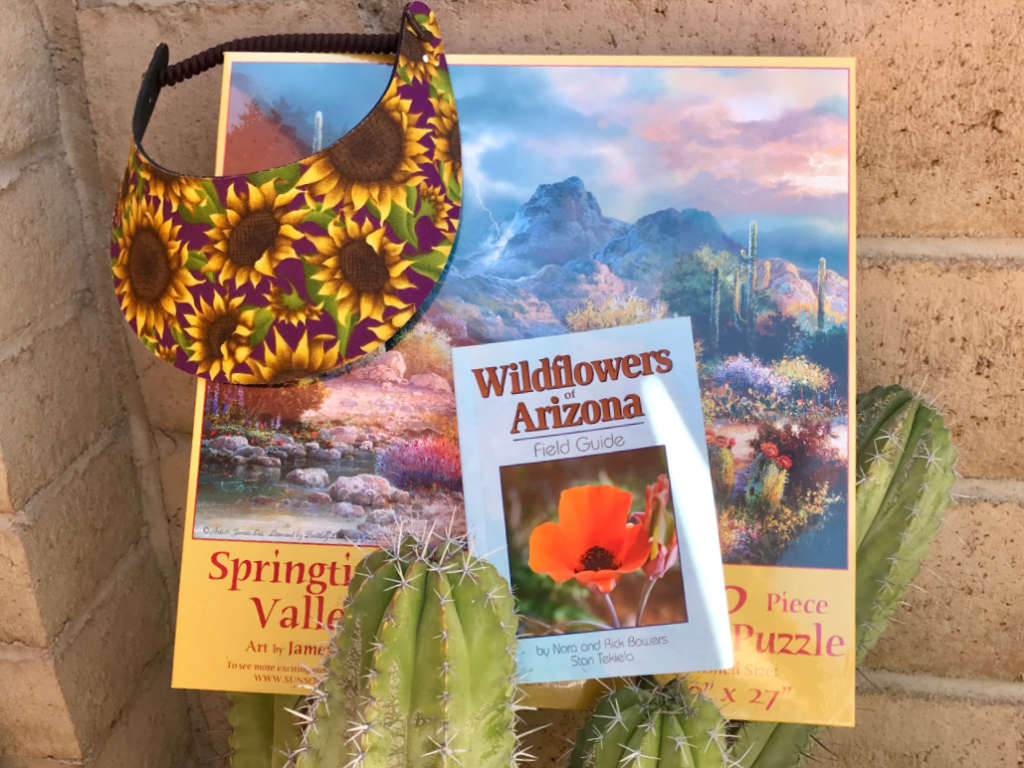
Puzzle Box – $54
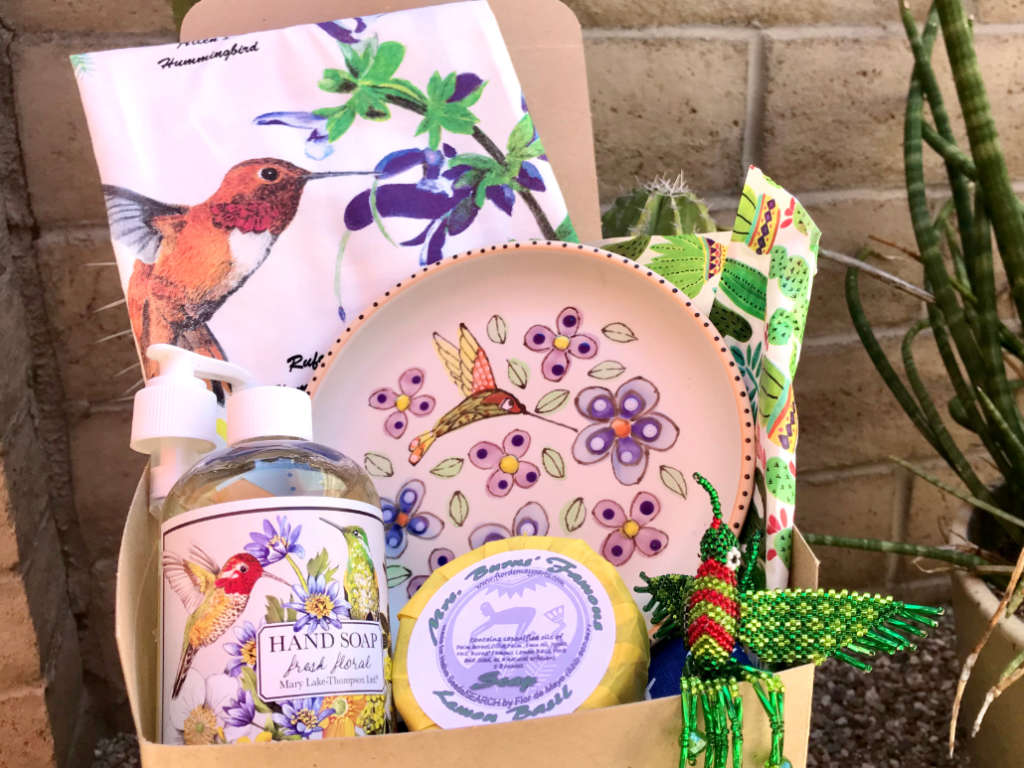
Hummingbird Box – $102
Make Some Flora And Fauna Origami!
Getting Started

Some Basics
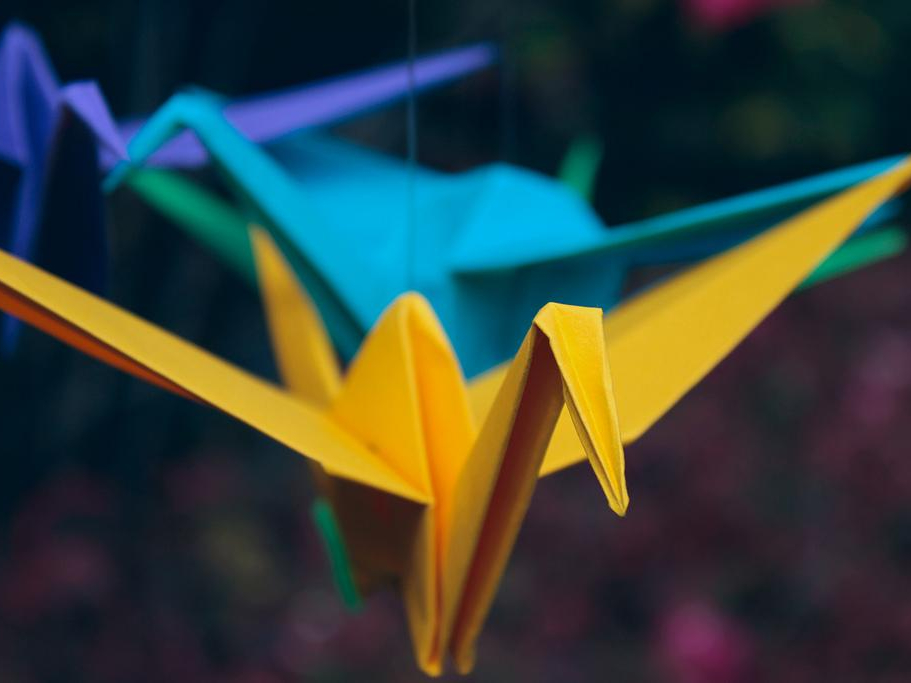
Start Your Own Menagerie

Make a potted plant
And some cactus
and some more cactus
Local Artists Inspired By Pollination
Ted Fleming

A Nectar Bat Visiting Agave Flowers
aluminum print
More
Most Sonoran Desert plants rely on animals to move their pollen from one to another. And most of these pollinators are small, low energy-demanding insects; but there are notable exceptions to this. Columnar cacti and paniculate agaves, for example, rely strongly on relatively large, energy-demanding hummingbirds and nectar-feeding bats as their major pollinators. This image shows a nectar-feeding bat, Leptonycteris yerbabuenae, visiting the inflorescence of the century plant, Agave palmeri, for a tongueful of nectar. It will repeatedly visit these and other agave flowers each night and will sometimes carry pollen several kilometers between plants.
Mark Thaler
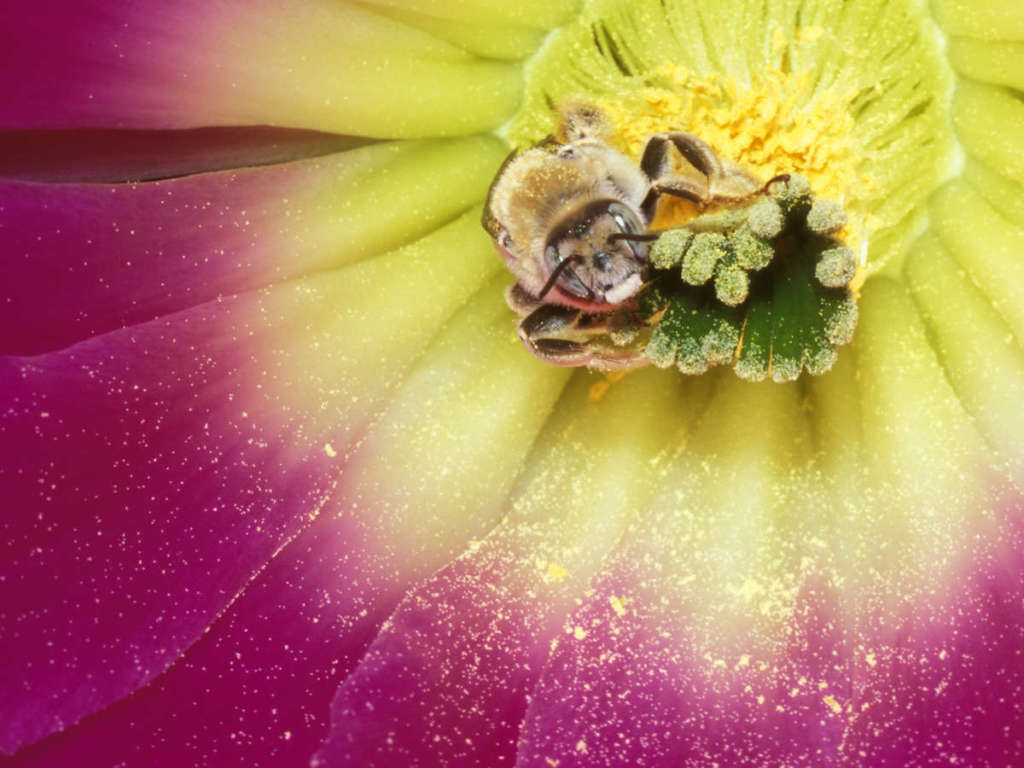
Sanctuary
archival pigment print
More
“Plants are surrounded by many possibilities; evolutions toward successful symbiotic relationships have become quite diverse and are amazingly creative. There are many vectors to pollination that include wind, water, insects, butterflies, birds, bats, and other animals that visit the flower. Working with specialized camera equipment, I seek to capture the energetic dance of bees as they visit and unintentionally pollinate the flowering plants around us. In this particular photo a digger bee (Family: Anthropodidae) finds a moment of rest within the flower of a ladyfinger cactus (Echinocereus pentalophus) surrounded by vibrant colors and a profusion of golden pollen grains.”
Jim Waid
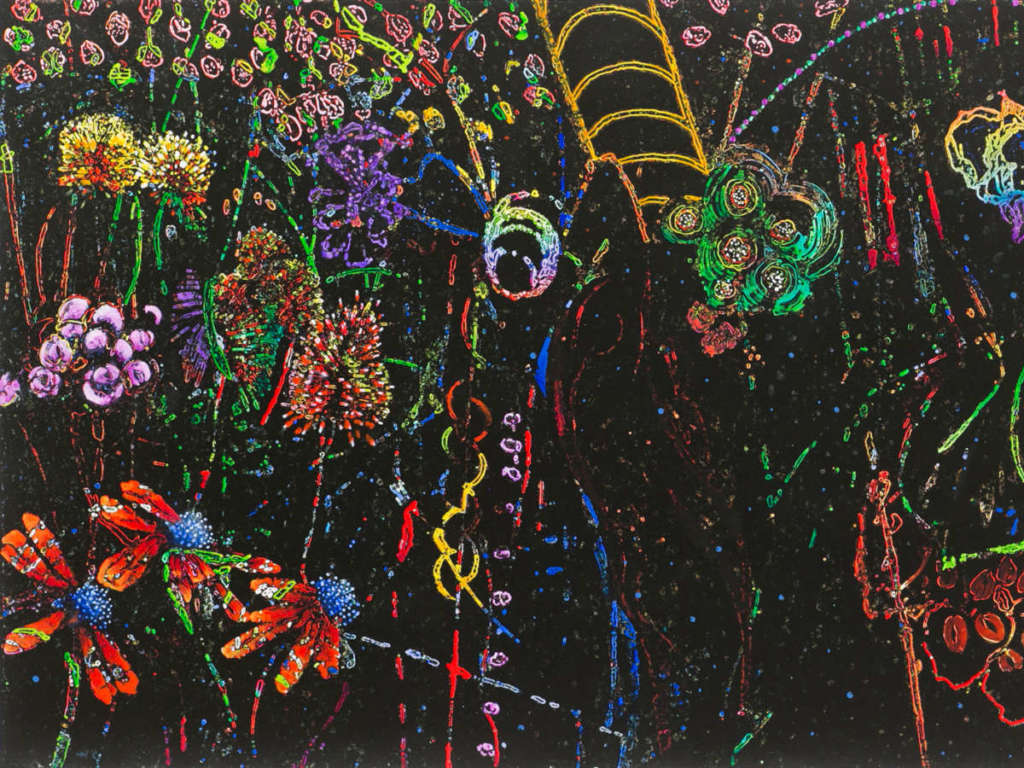
Pollen Flow
mixed media on paper mounted on board
More
“My work is intimately involved with the exchanges of energy between the dwellers of the
Sonoran Desert whether animal, insect or flora.”
“I can’t think of anything to say about flowers that doesn’t sound trite – except that they continue to fascinate and instruct.”
[expand title=”More Artists” rel=”fiction”]
Christopher Allison
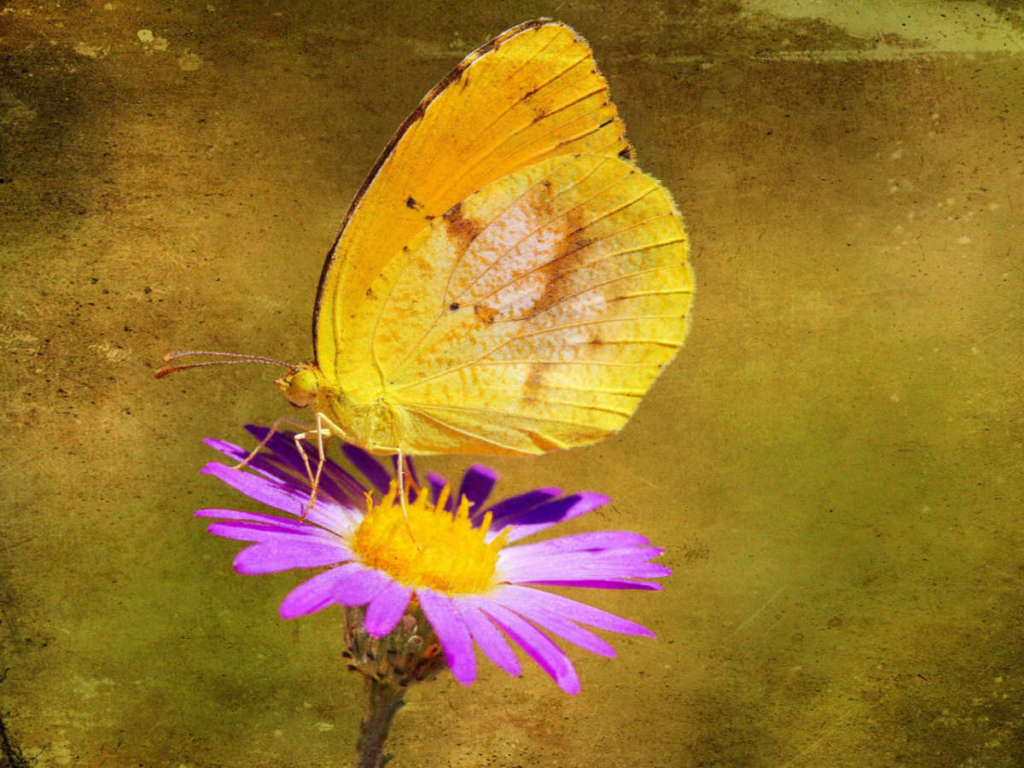
The Shielded Pollinator
modified photographic print
Christopher Allison
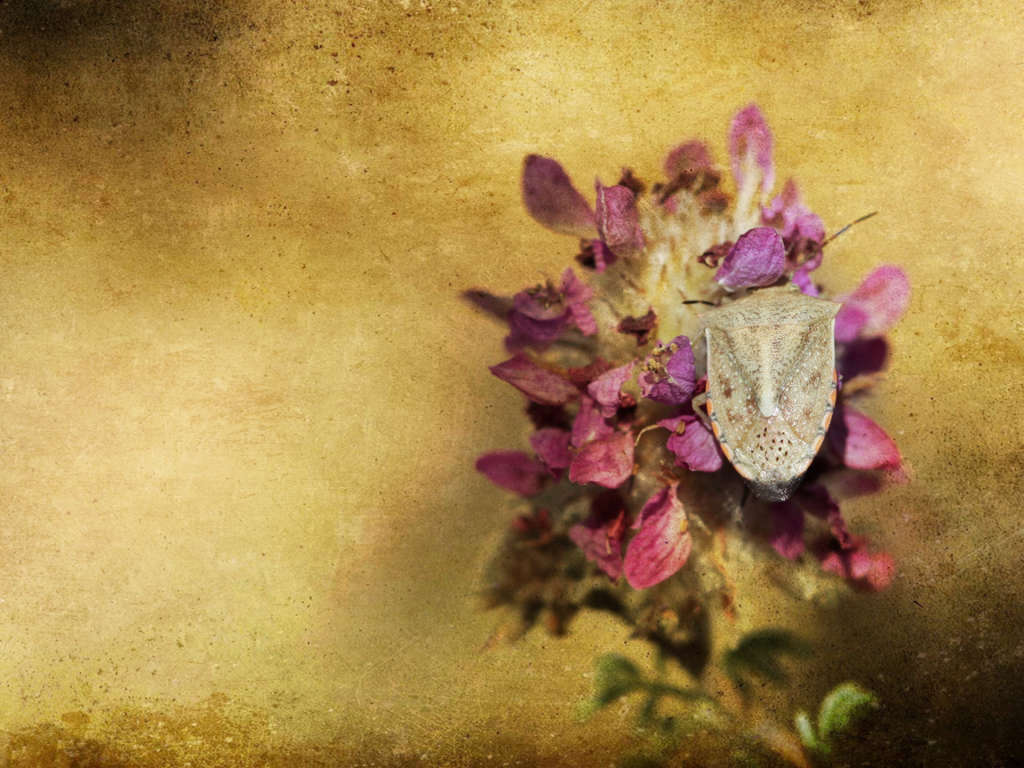
Sleepy Orange Butterfly
modified photographic print
Christopher Allison
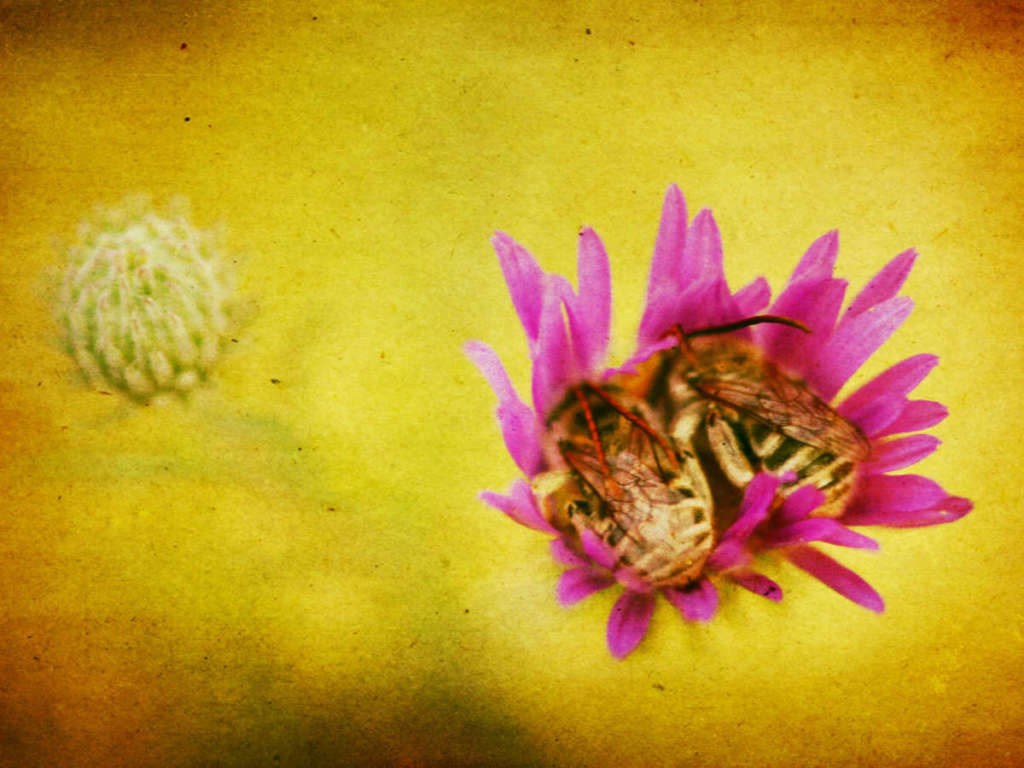
Bachelor Longhorned Bees
modified photographic print
More
“The relationships between flowers and their pollinators are fascinating and complex. Each of these photographs demonstrate examples where pollinating insects were using flowers for shelter. The bees and wasps returned to the same flowers nightly to roost. I photographed them at sunrise over several days. The Sleepy Orange Butterfly was clinging to an aster during warm gusts of wind. It remained there for some time calmly resting. These two photographs were taken near my home. I am fortunate to live in Tucson, a place where nature’s persistence and perseverance make it a constant companion. From abundant birdlife to a seemingly endless variety of insects I am constantly fascinated and inspired by my surroundings.”
The Shielded Pollinator
“The role of pollinator is not just limited to bees and butterflies. There is an incredible array of insects that are attracted to flowers. This shield bug rests among a cluster of flowers. Whether for shelter or food, this relationship demonstrates the deep connections found between plants and insects in the Sonoran Desert.”
“These two Bachelor Longhorned Bees were cradled in the slightly open petals of a Desert Aster early one morning. Some of the flowers that I observed had several bees clustered together each night. This social behavior is most likely done to help warn each other of the approach of predators.”
“This Sleepy Orange Butterfly stopped to rest on a Desert Aster during a windy day. I observed it for some time and noticed that it did not feed, but instead appeared to use the swaying flower for shelter.”
Alexandra Bowers
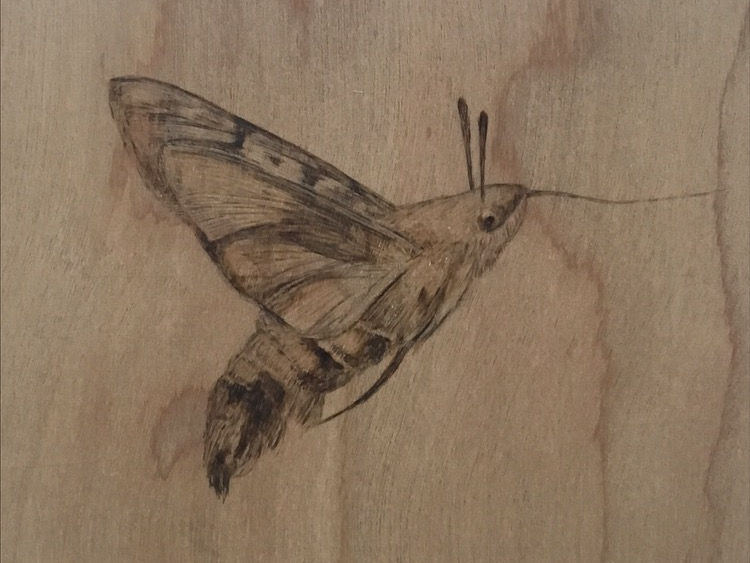
Hummingbird Moth
pyrography on birch panel
More
“What do you envision when you hear the word moth? Most people would think of pests, ugly brown winged creatures, or imagine their favorite sweater ruined by tiny holes.
Preconceived notions aside, moths are extraordinary creatures that roam this entire planet. They pollinate flowers and assist in sustaining ecosystems by providing a source of nourishment to animals higher up on the food chain. However, what I feel to be most important, is that they are thought of as an ‘indicator species’ which help humans detect vital changes in our environment.
With there being so many in existence, it’s fascinating to me how little we as humans think about them. And why should we? Most of the time we experience them in their most unfortunate light- literally when flying into streetlights, or when they’ve made their way into our homes.
Though these creatures have a bad rep for being considered ‘gross’ and a nuisance, they’re quite remarkable. Just like their sister the butterfly, they progress through four phases of life. The final ‘adult’ phase is what I’m interested in emphasizing with these pieces because it is the most recognizable, while at the same time typically the shortest in their metamorphosis. And though it may be brief, it’s the most powerful in their life story because it’s the stage that allows them to continue their legacy on this planet.”
Robin Westenhiser

It Happens Here Every Spring
acrylic on canvas
More
I am an allergy sufferer. My take on pollen… Have you ever wandered out at night and shown a flashlight high in the sky? It is startling, the swirl of dust and pollen that floats through the air and just how much there is!
Michael B. Mason
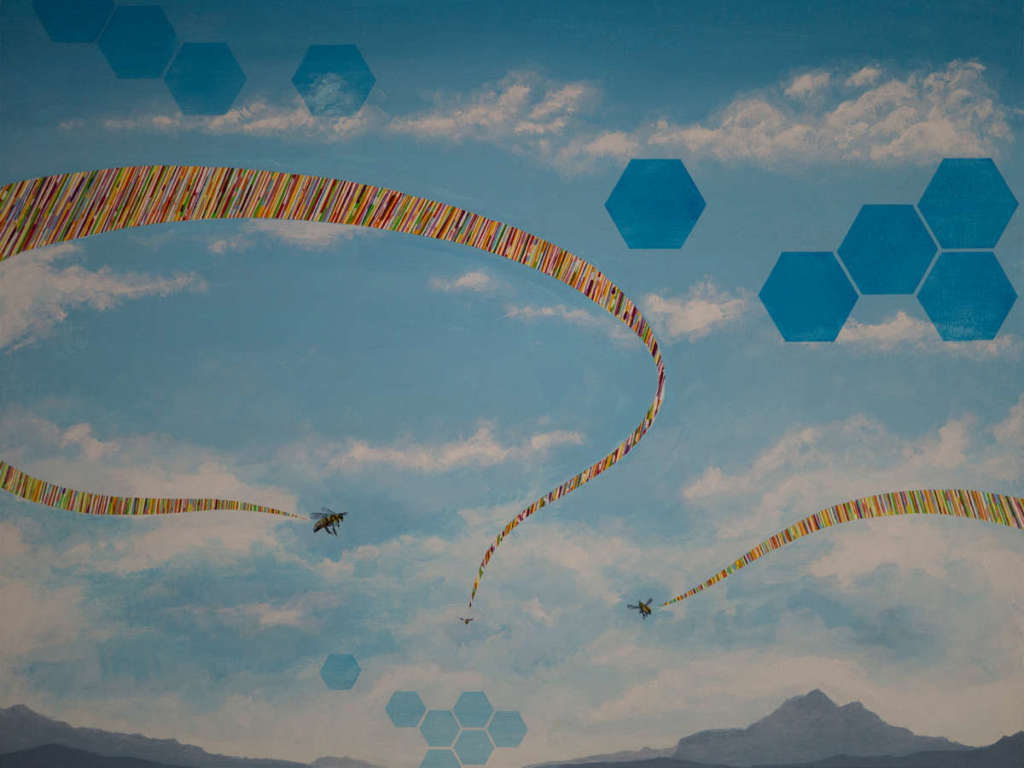
Sonoran Keystone
acrylic on panel
More
“Bees play a vital role in the perpetuation of life within the Sonoran Desert bioregion. Their work as pollinators ensures a new generation of plants and seasonal fruits, many of which are consumed by native wildlife as well as humans. Bees pollinate roughly 80% of the flora in the Sonoran Desert. Without bees, many native plant species would disappear, forever changing the landscape. Bees themselves benefit from the pollen they sew. This protein rich food source nourishes bees and their larva, and the sweet nectar they consume provides them with a quick boost of energy. Much of a bee’s activity goes unnoticed. They selflessly go about their business without adulation or fanfare. In Sonoran Keystone, I imagine bees that are much more noticeable. Bees that leave a contrail of colorful pollen as they fly through our desert sky illuminating the vital work they perform to sustain our ecosystem.”
[/expand]
Next Week’s Theme
